CHCDIS008: Facilitate Community Participation and Inclusion Report
VerifiedAdded on 2023/06/09
|6
|1055
|399
Report
AI Summary
This report, focusing on CHCDIS008, examines key aspects of community participation and social inclusion. It begins with an overview of the Disability Discrimination Act 1992, detailing its provisions against discrimination based on disability across various areas like employment, education, and access to services. The report then explores Human Rights, specifically the United Nations Convention on the Rights of Persons with Disabilities (UNCRPD), emphasizing the importance of protecting the rights and dignity of individuals with disabilities and promoting equality. Furthermore, it delves into the role of the Multicultural Disability Advocacy Association of NSW (MDAA), highlighting its advocacy services for non-English speakers and individuals with disabilities, focusing on improving access to services, informing them of their rights, and providing training and education. The report references several books and journals to support its findings, providing a comprehensive understanding of the legal, human rights, and advocacy frameworks surrounding disability and inclusion.
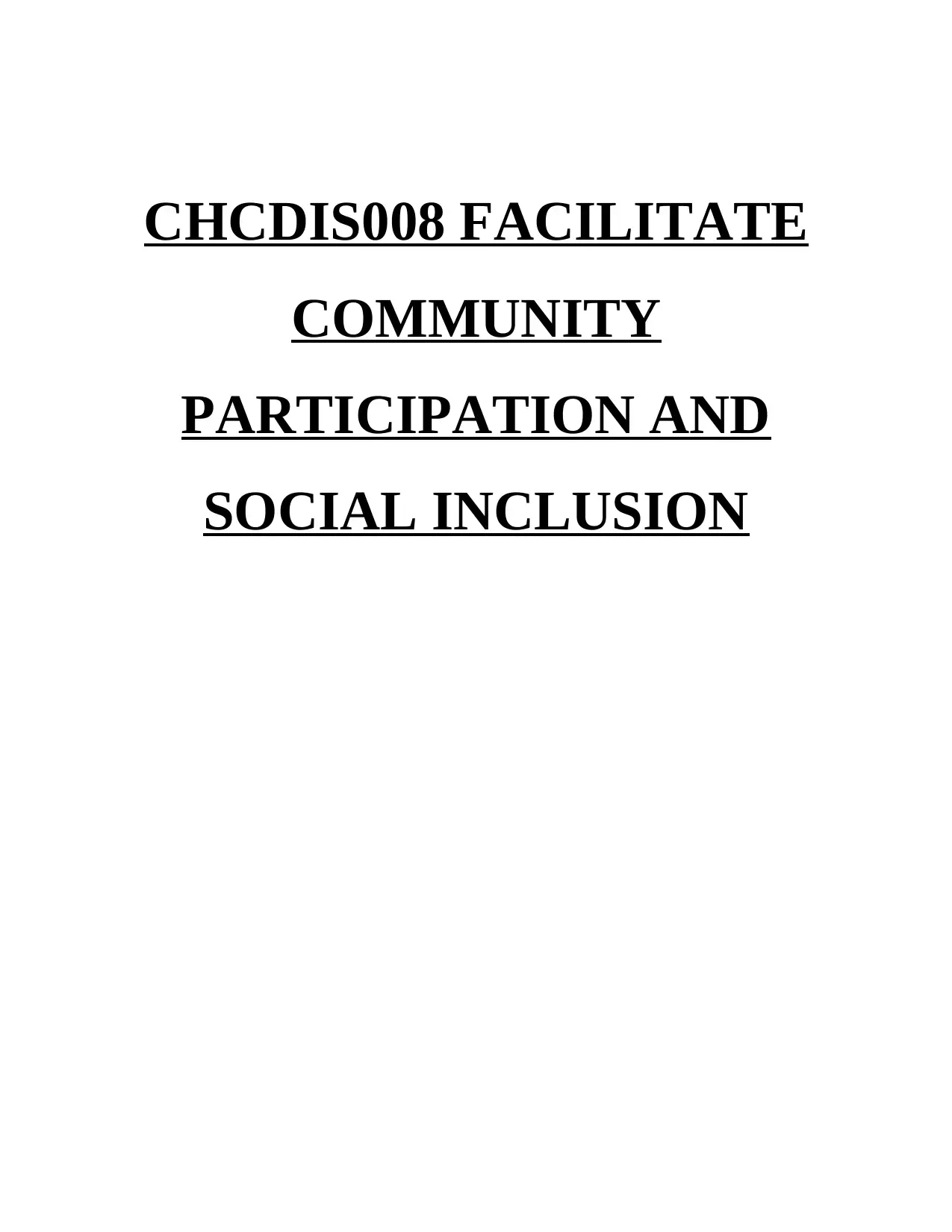
CHCDIS008 FACILITATE
COMMUNITY
PARTICIPATION AND
SOCIAL INCLUSION
COMMUNITY
PARTICIPATION AND
SOCIAL INCLUSION
Paraphrase This Document
Need a fresh take? Get an instant paraphrase of this document with our AI Paraphraser
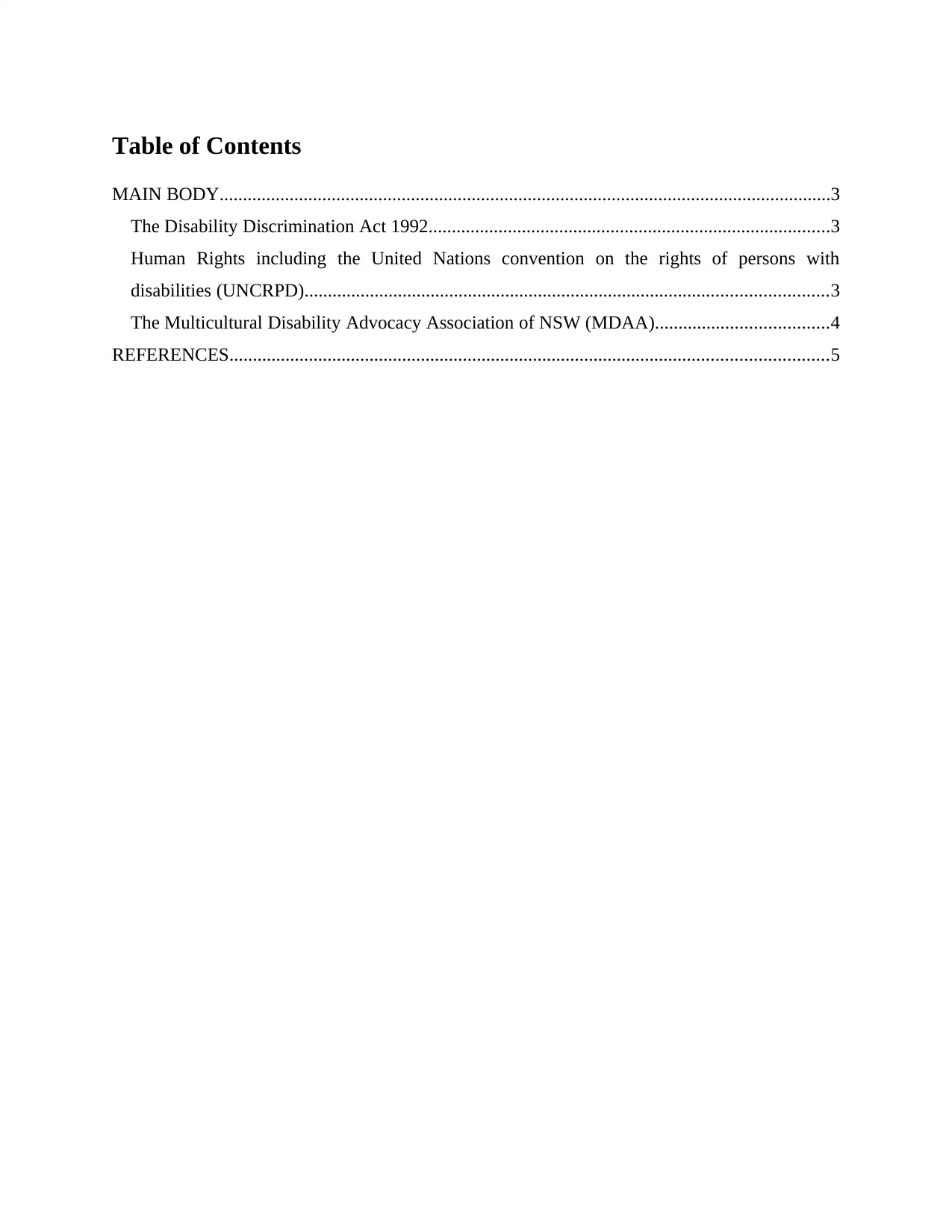
Table of Contents
MAIN BODY...................................................................................................................................3
The Disability Discrimination Act 1992......................................................................................3
Human Rights including the United Nations convention on the rights of persons with
disabilities (UNCRPD)................................................................................................................3
The Multicultural Disability Advocacy Association of NSW (MDAA).....................................4
REFERENCES................................................................................................................................5
MAIN BODY...................................................................................................................................3
The Disability Discrimination Act 1992......................................................................................3
Human Rights including the United Nations convention on the rights of persons with
disabilities (UNCRPD)................................................................................................................3
The Multicultural Disability Advocacy Association of NSW (MDAA).....................................4
REFERENCES................................................................................................................................5
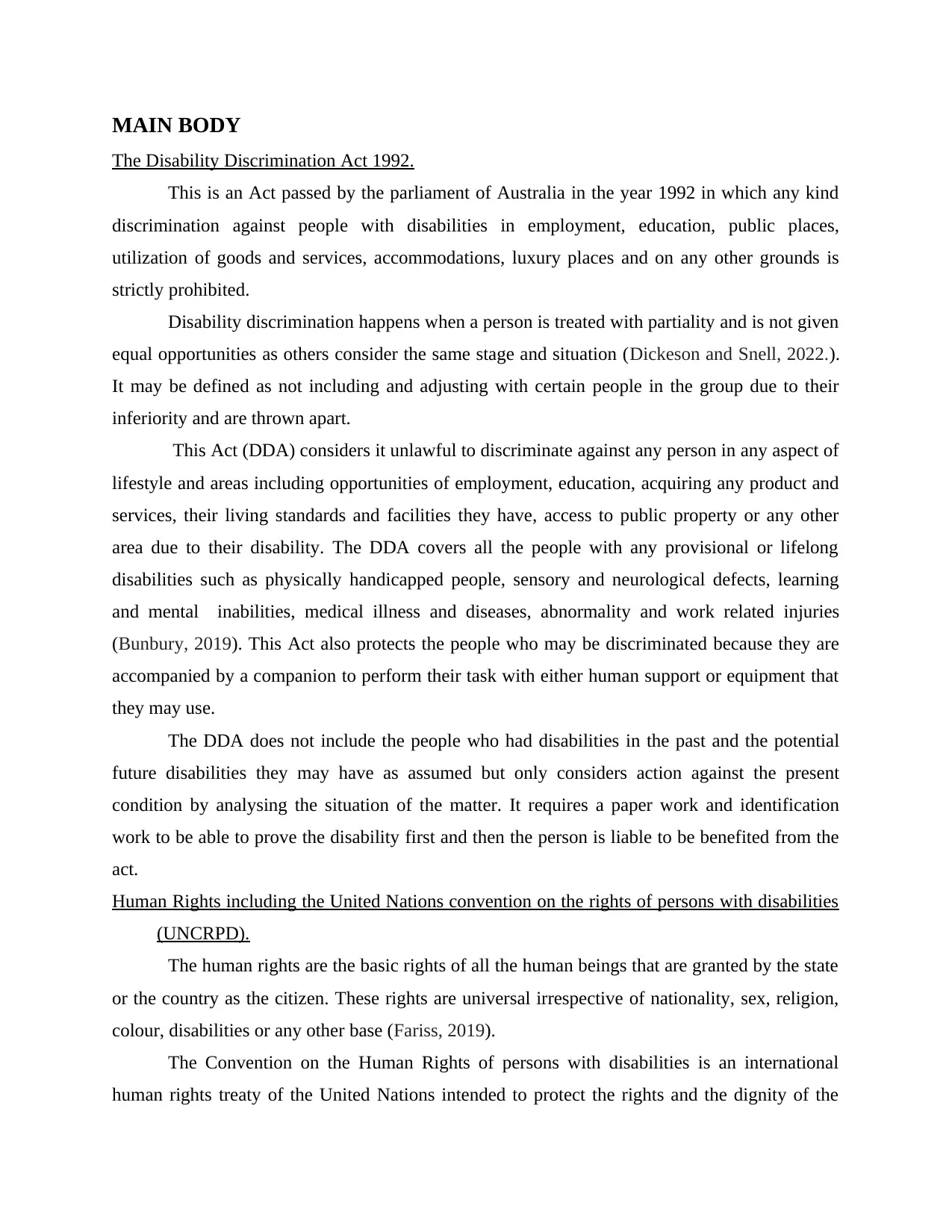
MAIN BODY
The Disability Discrimination Act 1992.
This is an Act passed by the parliament of Australia in the year 1992 in which any kind
discrimination against people with disabilities in employment, education, public places,
utilization of goods and services, accommodations, luxury places and on any other grounds is
strictly prohibited.
Disability discrimination happens when a person is treated with partiality and is not given
equal opportunities as others consider the same stage and situation (Dickeson and Snell, 2022.).
It may be defined as not including and adjusting with certain people in the group due to their
inferiority and are thrown apart.
This Act (DDA) considers it unlawful to discriminate against any person in any aspect of
lifestyle and areas including opportunities of employment, education, acquiring any product and
services, their living standards and facilities they have, access to public property or any other
area due to their disability. The DDA covers all the people with any provisional or lifelong
disabilities such as physically handicapped people, sensory and neurological defects, learning
and mental inabilities, medical illness and diseases, abnormality and work related injuries
(Bunbury, 2019). This Act also protects the people who may be discriminated because they are
accompanied by a companion to perform their task with either human support or equipment that
they may use.
The DDA does not include the people who had disabilities in the past and the potential
future disabilities they may have as assumed but only considers action against the present
condition by analysing the situation of the matter. It requires a paper work and identification
work to be able to prove the disability first and then the person is liable to be benefited from the
act.
Human Rights including the United Nations convention on the rights of persons with disabilities
(UNCRPD).
The human rights are the basic rights of all the human beings that are granted by the state
or the country as the citizen. These rights are universal irrespective of nationality, sex, religion,
colour, disabilities or any other base (Fariss, 2019).
The Convention on the Human Rights of persons with disabilities is an international
human rights treaty of the United Nations intended to protect the rights and the dignity of the
The Disability Discrimination Act 1992.
This is an Act passed by the parliament of Australia in the year 1992 in which any kind
discrimination against people with disabilities in employment, education, public places,
utilization of goods and services, accommodations, luxury places and on any other grounds is
strictly prohibited.
Disability discrimination happens when a person is treated with partiality and is not given
equal opportunities as others consider the same stage and situation (Dickeson and Snell, 2022.).
It may be defined as not including and adjusting with certain people in the group due to their
inferiority and are thrown apart.
This Act (DDA) considers it unlawful to discriminate against any person in any aspect of
lifestyle and areas including opportunities of employment, education, acquiring any product and
services, their living standards and facilities they have, access to public property or any other
area due to their disability. The DDA covers all the people with any provisional or lifelong
disabilities such as physically handicapped people, sensory and neurological defects, learning
and mental inabilities, medical illness and diseases, abnormality and work related injuries
(Bunbury, 2019). This Act also protects the people who may be discriminated because they are
accompanied by a companion to perform their task with either human support or equipment that
they may use.
The DDA does not include the people who had disabilities in the past and the potential
future disabilities they may have as assumed but only considers action against the present
condition by analysing the situation of the matter. It requires a paper work and identification
work to be able to prove the disability first and then the person is liable to be benefited from the
act.
Human Rights including the United Nations convention on the rights of persons with disabilities
(UNCRPD).
The human rights are the basic rights of all the human beings that are granted by the state
or the country as the citizen. These rights are universal irrespective of nationality, sex, religion,
colour, disabilities or any other base (Fariss, 2019).
The Convention on the Human Rights of persons with disabilities is an international
human rights treaty of the United Nations intended to protect the rights and the dignity of the
⊘ This is a preview!⊘
Do you want full access?
Subscribe today to unlock all pages.

Trusted by 1+ million students worldwide
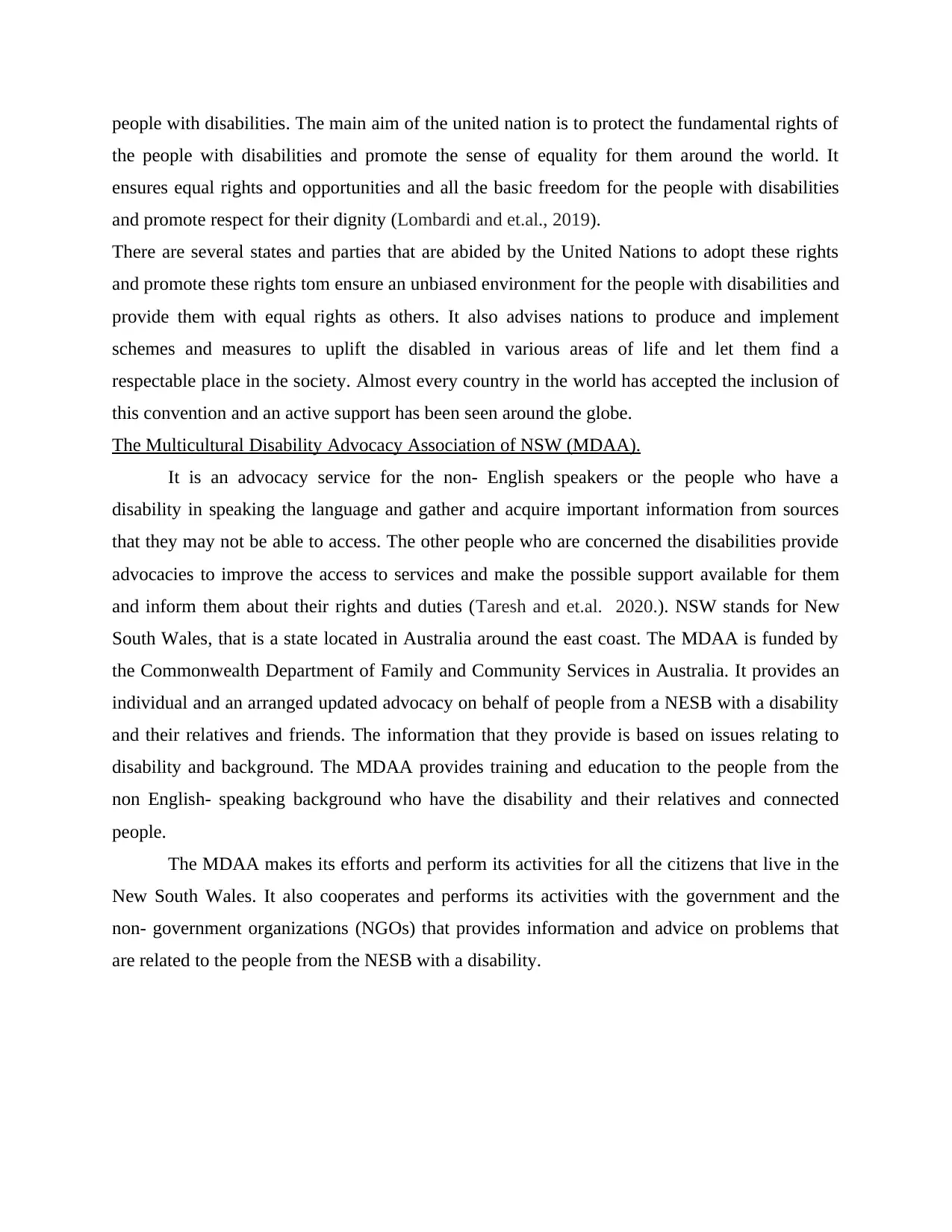
people with disabilities. The main aim of the united nation is to protect the fundamental rights of
the people with disabilities and promote the sense of equality for them around the world. It
ensures equal rights and opportunities and all the basic freedom for the people with disabilities
and promote respect for their dignity (Lombardi and et.al., 2019).
There are several states and parties that are abided by the United Nations to adopt these rights
and promote these rights tom ensure an unbiased environment for the people with disabilities and
provide them with equal rights as others. It also advises nations to produce and implement
schemes and measures to uplift the disabled in various areas of life and let them find a
respectable place in the society. Almost every country in the world has accepted the inclusion of
this convention and an active support has been seen around the globe.
The Multicultural Disability Advocacy Association of NSW (MDAA).
It is an advocacy service for the non- English speakers or the people who have a
disability in speaking the language and gather and acquire important information from sources
that they may not be able to access. The other people who are concerned the disabilities provide
advocacies to improve the access to services and make the possible support available for them
and inform them about their rights and duties (Taresh and et.al. 2020.). NSW stands for New
South Wales, that is a state located in Australia around the east coast. The MDAA is funded by
the Commonwealth Department of Family and Community Services in Australia. It provides an
individual and an arranged updated advocacy on behalf of people from a NESB with a disability
and their relatives and friends. The information that they provide is based on issues relating to
disability and background. The MDAA provides training and education to the people from the
non English- speaking background who have the disability and their relatives and connected
people.
The MDAA makes its efforts and perform its activities for all the citizens that live in the
New South Wales. It also cooperates and performs its activities with the government and the
non- government organizations (NGOs) that provides information and advice on problems that
are related to the people from the NESB with a disability.
the people with disabilities and promote the sense of equality for them around the world. It
ensures equal rights and opportunities and all the basic freedom for the people with disabilities
and promote respect for their dignity (Lombardi and et.al., 2019).
There are several states and parties that are abided by the United Nations to adopt these rights
and promote these rights tom ensure an unbiased environment for the people with disabilities and
provide them with equal rights as others. It also advises nations to produce and implement
schemes and measures to uplift the disabled in various areas of life and let them find a
respectable place in the society. Almost every country in the world has accepted the inclusion of
this convention and an active support has been seen around the globe.
The Multicultural Disability Advocacy Association of NSW (MDAA).
It is an advocacy service for the non- English speakers or the people who have a
disability in speaking the language and gather and acquire important information from sources
that they may not be able to access. The other people who are concerned the disabilities provide
advocacies to improve the access to services and make the possible support available for them
and inform them about their rights and duties (Taresh and et.al. 2020.). NSW stands for New
South Wales, that is a state located in Australia around the east coast. The MDAA is funded by
the Commonwealth Department of Family and Community Services in Australia. It provides an
individual and an arranged updated advocacy on behalf of people from a NESB with a disability
and their relatives and friends. The information that they provide is based on issues relating to
disability and background. The MDAA provides training and education to the people from the
non English- speaking background who have the disability and their relatives and connected
people.
The MDAA makes its efforts and perform its activities for all the citizens that live in the
New South Wales. It also cooperates and performs its activities with the government and the
non- government organizations (NGOs) that provides information and advice on problems that
are related to the people from the NESB with a disability.
Paraphrase This Document
Need a fresh take? Get an instant paraphrase of this document with our AI Paraphraser
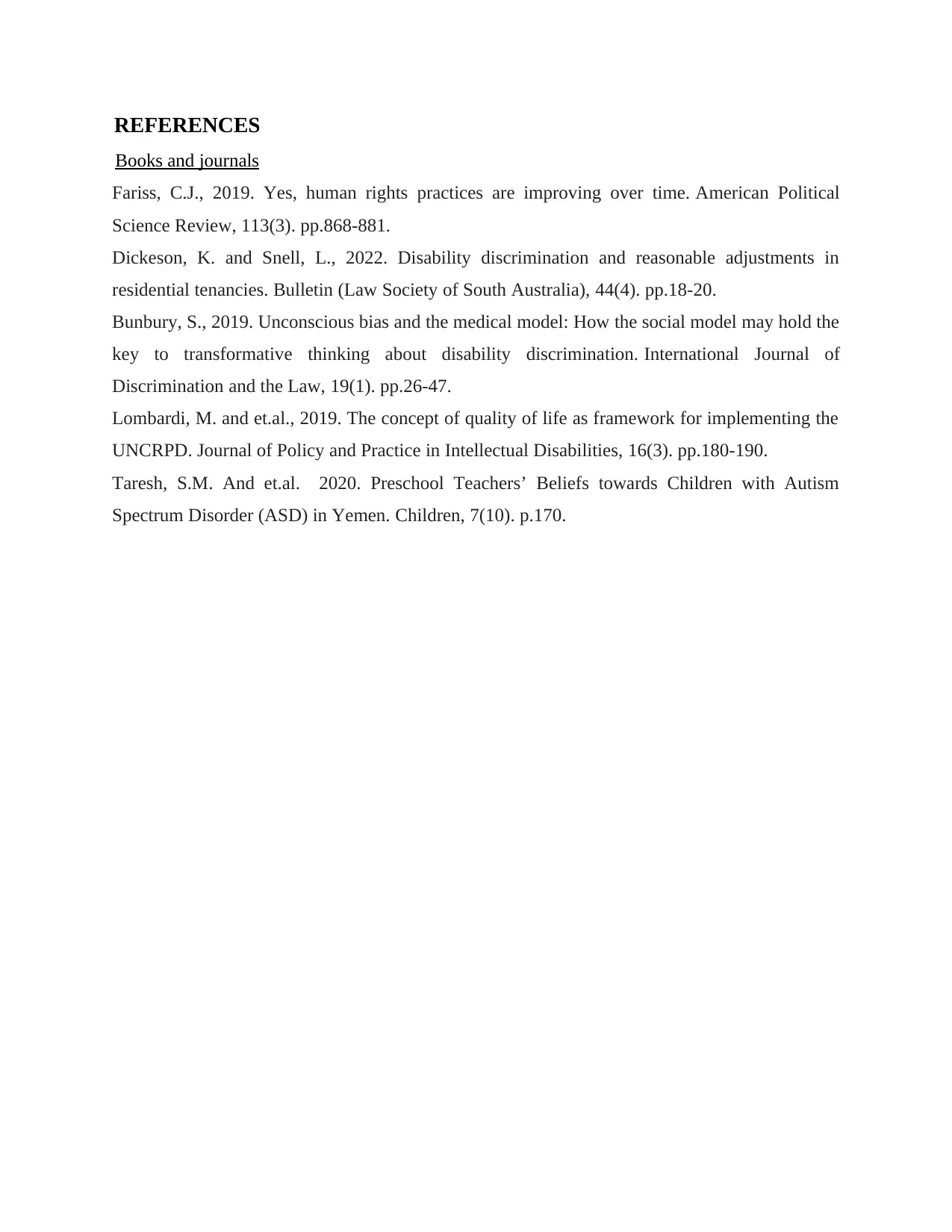
REFERENCES
Books and journals
Fariss, C.J., 2019. Yes, human rights practices are improving over time. American Political
Science Review, 113(3). pp.868-881.
Dickeson, K. and Snell, L., 2022. Disability discrimination and reasonable adjustments in
residential tenancies. Bulletin (Law Society of South Australia), 44(4). pp.18-20.
Bunbury, S., 2019. Unconscious bias and the medical model: How the social model may hold the
key to transformative thinking about disability discrimination. International Journal of
Discrimination and the Law, 19(1). pp.26-47.
Lombardi, M. and et.al., 2019. The concept of quality of life as framework for implementing the
UNCRPD. Journal of Policy and Practice in Intellectual Disabilities, 16(3). pp.180-190.
Taresh, S.M. And et.al. 2020. Preschool Teachers’ Beliefs towards Children with Autism
Spectrum Disorder (ASD) in Yemen. Children, 7(10). p.170.
Books and journals
Fariss, C.J., 2019. Yes, human rights practices are improving over time. American Political
Science Review, 113(3). pp.868-881.
Dickeson, K. and Snell, L., 2022. Disability discrimination and reasonable adjustments in
residential tenancies. Bulletin (Law Society of South Australia), 44(4). pp.18-20.
Bunbury, S., 2019. Unconscious bias and the medical model: How the social model may hold the
key to transformative thinking about disability discrimination. International Journal of
Discrimination and the Law, 19(1). pp.26-47.
Lombardi, M. and et.al., 2019. The concept of quality of life as framework for implementing the
UNCRPD. Journal of Policy and Practice in Intellectual Disabilities, 16(3). pp.180-190.
Taresh, S.M. And et.al. 2020. Preschool Teachers’ Beliefs towards Children with Autism
Spectrum Disorder (ASD) in Yemen. Children, 7(10). p.170.

6
⊘ This is a preview!⊘
Do you want full access?
Subscribe today to unlock all pages.

Trusted by 1+ million students worldwide
1 out of 6
Related Documents
Your All-in-One AI-Powered Toolkit for Academic Success.
+13062052269
info@desklib.com
Available 24*7 on WhatsApp / Email
![[object Object]](/_next/static/media/star-bottom.7253800d.svg)
Unlock your academic potential
Copyright © 2020–2025 A2Z Services. All Rights Reserved. Developed and managed by ZUCOL.




